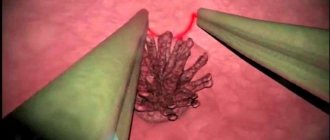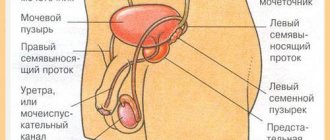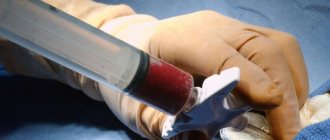Consultations
Abramov Georgy Borisovich,
Dermatovenerologist, trichologist
Question:
Hello. A trichologist diagnosed AGA based on a phytotrichogram. At that time I...
Hello! I read your letter carefully. Of course, in order for me to give a proper answer to...
Abramov Georgy Borisovich (dermatovenereologist, trichologist)" class="ask">
Zharov Evgeniy Valerievich,
gynecologist
Question:
Hello, please tell me, my boyfriend and I visited last night around 12 am...
good evening, the presence of bloody discharge is always a very serious symptom. there are many reasons and...
Zharov Evgeniy Valerievich (gynecologist)" class="ask">Ask a question
You must be logged in to ask questions.
You must log in to the site.
Features of the operation
To create a new bladder, the surgeon will need tissue from the patient's intestines - the hollow sigmoid colon, rectum or ileum. Also today, scientific experts are working on innovative methods for creating internal organs from fibroblasts and stem cells. Individual organ fragments are first grown artificially and then sewn together by hand. However, this method is still in development, so a technique that involves using parts of the intestine is more often used.
Formation of the bladder from the ileum. Source: urologi.ru
You need to understand that plastic surgery of the ureters, bringing them to the abdominal wall or into the rectum, is not the creation of an artificial bladder. With this operation, a reservoir is not created, and urine leaves the body through the rectum along with feces. This operation has dangerous consequences for the body, since harmful intestinal microorganisms gain free access to the urinary tract and cause chronic inflammation.
In the process of creating a bladder from the ileum, the surgeon removes the desired part of the tissue and tightly stitches the lumen in the intestine. After this, the reservoir connects to the ureters and urethra, turning into a bag. The patient’s urine will now accumulate in it. If the urethra is damaged, the doctor attaches a tube that comes out in the navel area.
Life with an artificial bladder
After the operation to install the bladder, in order to avoid rupture of postoperative sutures, it is necessary to avoid overfilling it . To ensure uniform outflow of urine, a catheter is inserted through the urethra into an artificial bladder. The catheter must be attached to a urine collection bag fixed on the leg.
To avoid the formation of stones in the artificial bladder, it is necessary to periodically flush the bladder and catheter with saline.
Before and after flushing the catheter, a number of rules must be followed:
- The saline solution should be at room temperature.
- Before flushing the catheter, it is necessary to wash the external genitalia and hands.
- In order for the catheter to be inserted well, it must be wiped with petroleum jelly.
The catheter is removed two weeks after surgery.
Within a year after the installation of a bladder, a person will constantly feel fullness, as well as urinary incontinence. But this phenomenon is fixable, you just need to strengthen the pelvic muscles.
You should also drink plenty of water. Physical activity is allowed only one year after the operation.
Men, after installation of an artificial bladder, may initially experience problems in their intimate life.
Installation of the bladder and indications for it
An artificial bladder is formed in the following ways:
- Heterotopic plastic surgery, urostomy . (Creation of a reserve with urine diversion to the anterior wall of the human peritoneum). A cavity is created from the intestine, which is connected to the anterior wall of the peritoneum using a special opening (urostomy). The ureter moves to a separate part of the intestine. Urine is released through a catheter or stoma.
A stoma is a connecting opening between an organ and the external environment. With this type of operation, complications will be minimal.
- Orthotopic plastic surgery . It is used if there are no cancerous tumors in the urethra. The bladder is created from the lower part of the small intestine. This bladder is connected to the urinary organ and urethra. After installing such a bladder, a person will not feel the urge to urinate due to the removal of nerve endings during surgery. It will be necessary to regularly tense your abdominal muscles.
The advantages of an orthotopic bladder when removing forty centimeters of intestine are:
- Creating a reliable storage facility for urine outflow.
- The serous-gray tunnels of the urethra protect the walls from contact with urine.
- Less traumatic.
- The urethral tunnel can be of varying lengths.
- Reliable retention of urine if the urethral valve is intact.
- Restoring urination naturally.
- Resistance to infections.
- Possibility of internal hematoma formation.
- Metabolic problems.
- Possibility of urine leakage through surgical sutures.
- Cancerous tumors of the bladder.
- Various injuries.
- Congenital pathologies, exstrophy.
- Paralysis.
- Reducing the size of the bladder.
The disadvantage of this method is the inability to control urination.
When removing sixty centimeters of intestine, there are the following advantages:
The disadvantages of this method are:
The capacity of the bladder from the intestines is 0.5 liters.
Indications for installation of an artificial bladder are:
In case of congenital pathologies of the bladder, the operation is performed within a week after the birth of the child.
There are the following contraindications for installing a bladder from the intestine:
- Kidney failure.
- Serious liver diseases.
- Acute kidney inflammation.
- Mental illnesses.
- Malignant tumors of the last stages.
The operation is not recommended for persons over seventy years of age.
In the weeks before surgery, the patient needs to establish an appropriate diet, cleansing enemas, and suppression of the microflora of the gastrointestinal tract.
The choice of method for draining urine from the body depends on a number of factors:
- Patient's age.
- Stages of cancer.
- Surgeon experience.
- The wishes of the person being operated on.
- From the condition of the organs of the genitourinary system.
The surgical operation to install an artificial bladder is divided into several stages:
- Formation of a path for the outflow of urine (a part of the intestine is cut off and sewn together with vessels)
- The ureters move into the abdominal cavity.
- A connection is made between the urethra and part of the intestine, and a catheter is inserted.
- Establishment of a stoma.
- The wounds are sutured and a bandage is applied.
After operation
The walls of the intestine and bladder have significant differences. That is why doctors strongly advise that after surgery, try not to fill the new reservoir to the limit. To control this process, a catheter is installed in the patient for a while. For several weeks, the patient is prescribed bed rest and a special diet.
- What is a bladder stoma and why is it needed?
The intestines are covered from the inside with glands that secrete mucous secretions and enzymes. Because of this, the catheter often becomes clogged, and stones can form in the bladder. To avoid such serious complications, doctors rinse the new bladder with saline solution, which is injected through a catheter. Gradually, the glands will atrophy on their own, and this procedure can be abandoned.
A few weeks after the surgical procedure, the patient must undergo a follow-up examination. The doctor assesses the consistency of the new bladder and the condition of the sutures. Complex diagnostics, as a rule, includes x-rays with a contrast agent and computed tomography. If no abnormalities are detected, the catheter can be removed and a course of rehabilitation can begin to return to normal life.
Indications for surgery
Urine released from the kidneys enters the bladder. When the reservoir begins to stretch, the nerve endings on its walls react. At the same time, the person understands that the urinary tract is full and needs to visit the toilet. Fluid flows out of the body through the urethra, and this process is regulated by the sphincter.
Some people have congenital abnormalities of the bladder or no bladder at all. In this case, doctors recommend a surgical operation, during which the ureters are brought to the abdominal wall, and an external reservoir is attached to them. Not only does it not look aesthetically pleasing. Patients after such an operation are at risk of developing inflammatory processes in the kidneys and ureteral stenosis.
In addition to congenital anomalies, the indication for creating an artificial bladder is a cancerous tumor in the organ. If the cancer is at a late stage of development, doctors recommend the patient complete removal of the bladder. An emergency operation to transplant a donor organ may be necessary if the organ is ruptured or severely injured. An artificial bladder will not be a complete replacement for the natural bladder, but it will still allow you to live a completely normal life.
Patient's life after surgery
It must be taken into account that the structure of the intestinal wall and the natural bladder is very different, so you cannot immediately load the newly formed reservoir. The patient is given a catheter, bed rest and a gentle diet are prescribed.
In addition, in the walls of the intestine there are many glands that secrete mucus and enzymes - this can clog the catheter and provoke the formation of stones.
Catheterization
To prevent such complications, the artificial bladder is rinsed daily with saline through a catheter.
In the future, the intestinal glands atrophy and washing can be done less frequently.
Approximately 2–3 weeks after surgery, an examination is performed by a specialist to determine the consistency of the reservoir, the quality of the anastomoses and sutures.
As a rule, a contrast X-ray examination or computed tomography is performed for this purpose.
If no pathologies were found during the examination, the catheter is removed and the artificial bladder begins to function.
- Suprapubic bladder catheter
After this, a long period of physical and psychological rehabilitation of the person begins. So, the most depressing factor is the inability to feel the bladder full. This often leads to urinary incontinence, especially at night.
The patient is taught to control the processes of urination, and the need to regularly visit the toilet is instilled. Depending on the volume of the reservoir, the amount of liquid consumed and a number of other individual indicators, it is necessary to relieve minor needs every 3–6 hours.
For the next 1.5–2 months after the operation, the person is prohibited from lifting weights or driving a car. In addition, it is during this period that most people psychologically adapt to their new state.
Psychological rehabilitation
In other words, for most patients, it is during this period that fears and uncertainty pass, as well as getting used to a new way of life.
If psychological problems persist, psychotherapy is necessary, and in rare cases, drug intervention.
A separate problem of surgery to form an artificial bladder in men is the preservation of erection and sexual function.
Currently, techniques have been developed and used to preserve most of the nerves in this area, which are responsible for penile erection.
However, even in such a situation, restoring normal sexual life takes a long time - from six months to 12 months. Unfortunately, there is no absolute guarantee of maintaining normal male strength after surgery.
Overactive bladder. How to live with it and how to train it
If you find it difficult to control your bladder, you can try these universal rules.
Your bladder is affected by the liquid you drink and sometimes the food you eat.
Too much liquid
If you drink a lot, you will urinate a lot. The bladder reacts acutely to rapid filling. This may cause a strong urge to urinate and difficulty holding urine. So don't drink too much at once.
Even in situations where you sweat a lot, try to drink small portions.
500 ml at each meal.
liquids, and between meals - no more than
250 ml
at a time.
If you often get up at night to go to the toilet:
- Drink more fluids in the morning or afternoon, but less in the evening;
- Limit alcohol and caffeinated drinks (they have a diuretic effect);
- Don't forget that liquid is not only water or tea, but also soup.
Too little liquid
If you drink little liquid, your urine will become concentrated. It becomes dark and has a pungent odor. Such urine irritates the bladder and makes you often run to the toilet.
What irritates the bladder?
In addition to concentrated urine, some foods can irritate the bladder:
- Sour fruits and fruit juices;
- Carbonated drinks;
- Hot and spicy food;
- Any products with tomatoes;
- Chocolate.
Try giving up these foods for a week and see what happens. If you feel better, then start returning one product every one to two days. So you will understand what makes it worse.
You don't have to completely give up your favorite foods. Sometimes it is enough to limit their number a little.
Bladder training
A hyperactive bladder can be trained.
Here's what to do:
- Start keeping a diary in which you note the time of each urination.
- Once you have determined the average time you can hold your urine, try increasing these intervals by 15 minutes
. For example, if you ran to the toilet every hour, then next time you go after 1 hour and 15 minutes.
- Gradually increase the time until you reach intervals of 2 – 4 hours
. This is already normal. - Then start sticking to the schedule. Go to the toilet immediately after you wake up. Next time, go on schedule. If your bladder is rebelling, try to be patient. While you are suffering, do not do your usual activities, but try to calm down, breathe deeply or do something that relaxes you. If it looks like there will be a leak, go to the toilet, but then again try to stick to a schedule.
Kegel exercises
These are exercises for the pelvic floor muscles. They help retain urine.
To find these muscles, imagine trying to stop a stream of urine.
You need to tense these muscles for about 3 seconds
, then relax for
3 seconds
and tense again.
This is done several times in a row. Usually it is recommended to repeat the exercises 3 – 4 times
a day. It is very important to do them in different body positions: lying, sitting and standing.
Medicines
The bladder is affected by drugs to lower blood pressure, diuretics, antihistamines, sleeping pills, antidepressants, and drugs that reduce muscle spasms. If you are prescribed something, be sure to warn your doctor about your bladder problems.
Excess weight
Excess weight literally puts pressure on top of the bladder and provokes incontinence. Keep your weight under control.
Smoking
Smokers tend to have more bladder problems. In addition, people who smoke often cough. This in itself can cause urine leakage. Stop smoking.
Exercise stress
They conducted special studies and found that regular physical activity helps control the bladder. Walking briskly for 30 minutes
most days of the week.
Constipation
Regular straining during bowel movements greatly stretches the pelvic floor muscles. After this, they are unable to hold urine. Talk to your doctor about constipation medications. This will help control your bladder.
Cough
Any cough can cause incontinence. Keep under control those diseases that are accompanied by a prolonged cough.
Try these rules if you have bladder problems. With regular practice, they have a very good effect. If something doesn’t work out, be sure to consult your doctor.
Source: https://zen.yandex.ru/media/id/5ad190241aa80c39a7a6a66d/5cf9cdc434ace300afb32851
Neoblase technology – orthotopic artificial bladder
The Neoblase technique is a bladder replacement using orthotopic transplantation. Orthotopic transplantation is the transplantation within the body of one organ or its fragment in place of another, with the corresponding transfer of organ functions.
A small fragment of tissue from which the walls of the small intestine are formed is transplanted into the place of the removed bladder. This selected fragment is given the shape of a ball, reproducing the contour of the bladder. The plastically formed bladder is connected (over the constipation muscle) to the urethra, so that after healing everything begins to function as before.
The operation to replace the bladder with an artificial one is performed microsurgically.
An innovative technique (Studer operation) allows the installation of an artificial bladder without frame devices (splints) guiding its formation.
The frameless technique guarantees faster healing and accelerated rehabilitation of the patient. In this case, the stay in the surgical hospital is limited to only two weeks.
The course of postoperative rehabilitation carried out in a hospital includes “continence training”. This is learning to use a new bladder.
The patient learns to confidently manage the excretory system so that annoying incontinence does not occur. In principle, upon discharge, he treats his new bladder (Neoblase) in the same way as he did with the old one when it was healthy.
If necessary, to normalize the activity of the constipating muscles, the patient receives special medications.
According to experts in the field of surgery and urology, Neoblase with Studer installation is an ideal bladder replacement option, allowing patients to return to a normal quality of life.
Catheter stoma
If, during bladder prosthetics using the Neoblase method, it is not possible to connect an artificial organ to the urethra, then a bypass excretory tract with an external stoma is installed. Stoma is an artificially formed external opening in surgeons' language.
In this case, the stoma is formed in the navel (Indiana-Pouch technique). Like the natural urethra, it is equipped with a constipation muscle.
This muscle is formed plastically and implanted from the inside into the navel funnel (from the outside, this anatomical “additive” remains invisible).
An artificial bladder, formed from a fragment of the small intestine, is connected to the umbilical stoma through a shut-off valve, which is also made from a small fragment of tissue from the intestinal wall.
The constipation muscle and valve prevent the spontaneous release of urine. To empty the bladder, the patient periodically inserts a special cleansing catheter into the stoma. From a hygienic and cosmetic point of view, this is an ideal solution if a person can no longer use the normal urethra.
Unification of the urinary system and intestines
Implantation using the Sigma-Rektum Pouch method aims to use the constipating muscles at the end of the intestines to control the release of both “your own” secretions and urine. Historically, this is the oldest technique for installing urinary bypass, the foundations of which were laid back in the 19th century.
Subsequently, it was modernized several times. Currently, operations to install the “intestinal bladder” are carried out in surgical and urological clinics in Germany to the highest standards, using innovative technology and achieving a completely comfortable result for patients.
Strictly speaking, in this case, it is not a bladder prosthesis that is performed, but a direct drainage of urine into the large intestine.
The ureters, which normally connect the kidneys to the bladder, are reconnected to the terminal segment of the intestine. Before the operation, the functions of the constipation muscles of the anus are tested.
She should be fine, because after the operation she will have to retain fluid in her rectum, along with the usual secretions.
Diversion of urine into the intestines is an alternative to the Neoblase method (artificial bladder). An alternative solution is taken if the natural urethra does not function (tumor or other pathological disorders).
Under such circumstances, a bladder replacement would be ineffective. Therefore, a “simplified” scheme is used - urine drainage without a bladder.
By the way, from a technical point of view, reconnecting the ureters to the intestines is really much simpler than forming a new bladder.
Conduit and urethrocutaneostomy
The word "conduit", familiar to us from a children's book, in medicine refers to an artificial tubular cavity formed in the body for certain physiological needs.
In this case, we mean the function of urine excretion, if it needs to be maintained without a bladder.
As in the case of the Sigma-Rektum Pouch, an artificial drainage channel is installed, only the urine does not flow into the intestines, but into a compact portable container glued to the skin on the abdomen.
To do this, the ureters are connected to the small intestine and urine is directed through an additional tube (conduit) 10-15 centimeters long to the intestine to the excretory opening (stoma).
Urine is released freely through the skin and accumulates in an external container, which must be emptied from time to time. The establishment of such an excretory canal is called urethrocutaneostomy. This technique with facilitated surgical intervention is especially indicated for elderly patients or people with general physical weakness.
Source: https://www.wp-german-med.ru/urologia/1052-iskusstvennyj-mochevoj-puzyr-protezirovanie-mochevydelitelnoj-sistemy.html
Bladder reconstruction in Israel: Neobladder operation
This involves creating a new bladder from a section of the patient's small or large intestine (or both) and connecting it to the urethra (urethra). Such an organ is capable of fully performing all the natural functions of the bladder. The reconstructed bladder allows urine to drain naturally and thus significantly improves the patient's quality of life after a cystectomy, eliminating the need to carry an external urine reservoir (as in the case of a urostomy).
- Bladder drainage using catheter stents
Despite all its advantages, bladder reconstruction is not indicated for every patient who has undergone a cystectomy. This is especially true for patients with intestinal pathologies or a history of cancer of the pelvic organs, as well as those whose cancer has spread to the urethra.
The reconstruction operation itself is performed using several techniques. The most commonly used reconstruction is according to Studer, in which a section of intestine 40-60 cm long is used to form the tissues of a new bladder. The ureters (ducts connecting the bladder and kidneys). A catheter is inserted into the new bladder through the urethra and used to drain urine for about 4 weeks while the patient recovers from surgery. The catheter is then removed.
If the patient refuses reconstruction surgery or it is contraindicated for him, to ensure normal urine drainage, a urostomy is performed - the creation of an external reservoir in which urine accumulates and is discharged through an opening in the abdominal wall. This operation is usually performed in parallel with a cystectomy. After urostomy, the patient needs to adapt to new conditions.
Another type of urostomy involves placing the reservoir not outside the patient's body, but in his abdominal cavity. This eliminates some of the inconveniences associated with a urostomy: for example, it eliminates the need to carry an external reservoir; the patient only needs to empty the internal abdominal reservoir through a catheter several times a day.
The bladder was removed - what to do next?
Surgery to remove the bladder, or cystectomy, is performed in cases where it is necessary to remove a pathological focus from the body (most often this is the location of a malignant neoplasm).
This is a radical operation and is the method of choice, so its use today is quite rare due to the development of medicine and the advent of modern and less traumatic treatment methods.
However, cystectomy is performed and there are a number of indications for this:
- Malignant neoplasm of the bladder in stage T4, but at M0;
- Diffuse papillomatosis;
- A large number of bladder tumors at stage T3;
- Shrinkage of the bladder in cases of its total defeat by Koch's tuberculosis bacillus or with interstitial cystitis.
Abroad, this operation can also be performed if the tumor is at an early stage, but there is a risk of relapse. This is due to the fact that for such patients, life after removal of the bladder will be much calmer, and after completing the full course of treatment, nothing will worry them.
Are there contraindications to bladder removal?
Like any other operation, cystectomy has a number of contraindications in which removal of the bladder is prohibited:
- The patient is in serious condition;
- The patient is elderly, because due to a weak heart he simply cannot withstand long-term anesthesia;
- The presence of severe concomitant diseases, which may cause complications in the postoperative period or during the operation;
- Diseases of the blood coagulation system, which can lead to massive bleeding during cystectomy;
- Acute inflammatory processes in the urinary organs that occur before removal of the bladder in men, the consequences of which can be sepsis (blood poisoning) due to infection entering the bloodstream.
How to prepare for bladder removal?
Before taking a person to the operating table, doctors carry out a number of measures to assess the patient’s condition, the risk of complications in the postoperative period and identify contraindications to this operation:
- A clinical blood and urine test and a biochemical blood test are performed to assess the patient’s general condition;
- Blood sugar level is determined;
- A series of tests are performed to determine blood clotting time and platelet levels to exclude diseases of the coagulation system;
- To identify concomitant diseases, the patient must undergo an ultrasound of the abdominal organs and a chest x-ray;
- To find out the nature and extent of damage to the bladder, cystoscopy with a biopsy is performed, which will help determine the tactics of anesthesia and surgery;
- Before a cystectomy, all hair in the groin and abdominal area must be shaved;
- A week before the scheduled operation, a liquid diet with minimal fiber content is prescribed;
- In the morning before removal, it is forbidden to eat.
What anesthesia is the operation performed under?
The most commonly used general anesthesia is endotracheal (intubation) anesthesia. With this anesthesia:
- The patient's airway will be completely patent, regardless of the position on the operating table;
- Prevents stomach contents from entering the airways;
- Despite prolonged anesthesia, the toxic effect of the drugs on the patient is minimal;
- The operation is facilitated by relaxing the muscles of the anterior abdominal wall (it becomes easier for surgeons to reach the bladder).
How is the bladder removed and what is it replaced with?
Today, the most common method is to remove the bladder in an open manner - the so-called laparotomy. This operation makes the surgeon’s work easier and takes much less time than using a laparoscope. Cystectomy technique:
- Initially, it is necessary to treat the patient’s skin with an antiseptic solution and isolate the surgical field;
- A urinary catheter must be inserted to drain urine throughout the operation;
- An arcuate suprapubic approach is used to expose and mobilize the bladder;
- After exposure and extraperitonealization (removal outside the abdominal cavity) of the bladder, its cavity is opened for inspection of the organ;
- The walls of the bladder (back and sides) must be mobilized;
- The posterior part of the prostate and seminal vesicles also need to be mobilized;
- In cases where the ureters have not been moved into the intestine in advance or brought to the skin, they are crossed, while retreating a couple of centimeters from the place where the tumor grows into their wall;
- A urinary catheter is installed;
- Ligation of the vas deferens is mandatory (at this stage you should be careful not to damage the wall of the rectum);
- The bladder is retracted back and up, the pubovesical and pubovesical ligaments together with the urethra are ligated and intersected so as not to touch the prostate;
- An ectomy of the bladder is performed, all bleeding is carefully stopped and bleeding vessels are sutured, peritoneal defects are eliminated and drainage is introduced into the pelvic cavity;
- A balloon-catheter is inserted into the urethra through the surgical wound of the anterolateral abdominal wall;
- A new organ is formed from the intestinal wall;
- The surgical wound is sutured in layers until drainage is achieved and an aseptic bandage is applied.
Abroad, a laparoscope is most often used to perform this operation, most often with the help of a da Vinci robot. This operation is easier to tolerate by the patient, is gentle, reduces possible wound infection and eliminates massive blood loss during the operation. Once the bladder has been removed, there are several options for replacing it.
Most often, a new organ is formed from the wall of the small intestine. 60 cm piece of tissue is taken from it , from which a spherical new bladder is made and sutured to the ureter and urinary canal. This is the easiest way to replace an organ and provides physiological urination.
But there are a number of contraindications to it:
- Presence of a tumor of the urethra;
- Celiac disease;
- Acute inflammatory bowel diseases;
- Malignant neoplasms of the intestine.
In such conditions, a new reservoir is created from the intestine, which is brought to the skin of the anterior abdominal wall. Usually the exit is located in the navel area. This will empty the reservoir using a catheter.
Another method of urination in such situations is a connection (anastomosis) between the ureters and the small intestine. In this case, a loop of the small intestine is removed to the skin and urine is collected in a special urinal.
In cases where the anal sphincter performs its function well enough, the ureter can be removed into the intestinal cavity. In such cases, urine will pass out along with feces through the rectum.
Prognosis after bladder removal
The prognosis depends on the stage and severity of the disease, as well as compliance with all doctor’s recommendations. Basically it is favorable. Life expectancy in men after surgery is up to tens of years, depending on the lifestyle the person leads.
The bladder was removed - what to do next?
After removal of the bladder and discharge from the hospital, life changes only in relation to urination. Periodically it will be necessary to change the urinal, empty the urine reservoir, and carefully monitor the hygiene of the intestinal loop or reservoir exposed to the skin.
And in cases where the new bladder was formed from the intestinal wall, the lifestyle does not change at all. The first two weeks, even if subsequent urination is physiological, urine will exit into the anterior abdominal cavity into the urinal. This is necessary for the engraftment of the new organ with the ureter and urethra.
After this, in the hospital the bladder is washed with antiseptic solutions. After the operation, you should not eat for a couple of days, since the intestines were also damaged during the cystectomy and time is needed for it to heal.
After two weeks, the catheters are removed, the sutures and drains are removed, and the person can continue to live their usual lifestyle, travel, play sports, and be sexually active.
Nutrition after bladder removal does not require strict diets. It is advisable to refrain from consuming foods rich in fiber. Dishes should be low in calories and contain a minimum of salt. Avoid eating spicy, fried and fatty foods. It is advisable to steam it without adding spices.
Source: https://brulant.ru/health/udalenie-mochevogo-puzyrya/
Structure
The bladder is a muscular, hollow organ whose functions are to collect, store and excrete urine through the urinary ducts.
Organs of the urinary system
It is located in the pelvis. The configuration of the bladder can be completely different, depending on the degree of its filling with urine, as well as on nearby internal organs.
It consists of an apex, body, bottom and neck, which gradually narrows and smoothly passes into the urethra.
The upper part is covered with peritoneum, which forms a kind of recess: in males it is rectovesical, and in females it is vesicouterine.
In the absence of urine in the organ, the mucous membrane gathers into peculiar folds.
The bladder sphincter controls urinary retention and is located at the junction of the bladder and the urethra.
The bladder in a healthy person allows you to collect from 200 to 400 ml of urinary fluid.
The external temperature and humidity may affect the amount of urine excreted.
Removal of accumulated urine occurs when the bladder contracts.
However, when pathologies occur, the mechanism for performing the basic functions of the bladder is seriously disrupted. This forces doctors to decide on plastic surgery.
Types of surgeries for bladder cancer
Surgeries for bladder cancer are performed using the traditional abdominal method - through an incision in the abdominal cavity. However, in Israel, minimally invasive surgical methods, such as laparoscopy, are more in demand. In this case, all manipulations are performed using an endoscope - a device with an optical system - and surgical instruments through several small incisions.
Moreover, in addition to manual techniques, the use of robotic systems is common in Israeli clinics. For example, the DaVinci robot-assisted surgical system allows the doctor to see a multiply enlarged surgical field in 3D and use joysticks to operate with four “arms” - the tools of the robot surgeon. This ensures greater accuracy of action, minimizes damage to adjacent tissues and the risk of postoperative complications, and accelerates healing and recovery.
At stages II and III of bladder cancer, in addition to radical cystectomy, removal of nearby tissues, lymph nodes and organs may be required. Such radical intervention often leads to irreversible consequences for sexual life and the reproductive system. So, in men, the prostate and the upper part of the urethra are removed. And in women, the uterus is completely removed along with the ovaries and fallopian tubes, the upper part of the vagina and the cervix. In order to minimize the extent of surgical intervention, before surgery, patients undergo a course of chemotherapy and radiation therapy, which reduces the size of the tumor.
Potential risks and complications after surgery for bladder cancer
Undesirable consequences are determined by the type and location of surgery, the general physical fitness and health of the patient, and the effects of other therapies (for example, tissue exposed to radiation may not heal properly after surgery).
- Pain is a consequence of tissue injury. Painkillers are used to control it. It may take some time for the pain to subside, depending largely on the procedure performed and the patient's pain threshold.
- Vomiting and nausea are consequences of general anesthesia. Medicines are often used to eliminate them.
- Hemorrhage or bleeding may rarely occur after surgery. It is normal to have a small amount of blood in the drain.
- After surgery for bladder cancer, problems with the urinary tract are possible. Some drugs used in anesthesia and pain medications may cause the inability to urinate. Repeated TUR can cause scarring in the bladder and lead to incontinence. After a partial cystectomy, due to a decrease in the size of the organ, more frequent urination is observed. After radical cystectomy and reconstruction, side effects such as urinary incontinence, blockage of the ureters, and backflow of urine into the ureters (reflux) are possible.
- Surgery in the pelvic area sometimes provokes intestinal irritation, causing various disorders. Paralytic intestinal obstruction occurs as a result of anesthesia, when the contents of the organ do not move. Food and fluid intake is gradually resumed after surgery. Narrowing (stricture) of the rectum is possible and is treated with dilatation (widening) and, in serious cases, surgery.
- With any type of surgery, wound infection is possible. A drain is placed in the wound area to drain excess fluid. Urinary tract infections after surgery for bladder cancer can be a complication. Such repeated infections develop with obstruction or reflux of the ureters and can provoke chronic pyelonephritis. To prevent and treat them, they resort to antibacterial therapy.
- After surgery for bladder cancer, stones may appear in the kidneys or the reconstructed bladder. It is important to drink plenty of fluids. If the condition does not improve, surgery may be necessary.
- Stenosis or narrowing of the stoma is a late complication that occurs as a consequence of ileal conduit. The disease is treated with dilation (widening) of the stoma.
- The formation of a hernia around the stoma can also be a late complication of ileal conduit. Surgery will be required to eliminate it.
- After reconstructive surgery, metabolic disorders are possible, for example, an imbalance of electrolytes - potassium and sodium. If necessary, supplements are prescribed to bring their levels back to normal.
- Reproductive disorders are a consequence of radical cystectomy, which changes the functioning of the reproductive system - infertility in women and erectile dysfunction in men. As the size of the vagina decreases in women and sensations during sex change, it happens that sexual intercourse is no longer possible.
Transurethral resection with fulguration (TUR)
This is a cystoscopic resection most commonly used to treat superficial tumors. It is sometimes used when there is minimal invasion of the bladder wall or to remove most of the growth before other treatment is involved. TUR with fulguration is performed using local, spinal and general anesthesia.
The surgeon inserts the cystoscope through the urethra and into the bladder. Removes the tumor using a special instrument inserted through a cystoscope. Some healthy tissue around the tumor is also resected. The doctor takes a sample of the bladder wall for testing to see if the cancer has invaded the muscles of the organ.
The base of the tumor is treated with high-energy electricity (fulguration) or laser to destroy any remaining abnormal cells.
Segmental (partial) cystectomy
This is an operation for bladder cancer, during which the tumor and part of the bladder around it are removed. It is performed under general anesthesia. Segmental cystectomy may only be an option for some patients. Contact her if:
- The low-grade tumor had invaded only one area in the bladder wall.
- The small, solitary mass is located in a location where it can be easily removed with clear surgical margins. There is no carcinoma in situ in other parts of the organ.
- The tumor occurs in a diverticulum, an abnormal protrusion of the wall of the bladder.
- The patient is not in good enough shape to undergo more extensive surgery for bladder cancer.
The functioning of the organ is preserved, the patient will be able to urinate in the usual way. But its size will decrease, and you will have to visit the toilet more often.
Radical cystectomy
This surgery for bladder cancer involves complete removal of the bladder and resection of the surrounding fatty tissue and adjacent lymph nodes. Performed under general anesthesia. In addition, in men, the prostate, seminal vesicles, and part of the urethra are also removed - radical cystoprostatectomy. In women - the uterus, cervix, fallopian tubes, ovaries, anterior vaginal wall and urethra - anterior exentaration of the small pelvis.
Radical cystectomy is performed in the following cases:
Cancer grows into the muscle layer of the bladder wall. Frequent recurrence of superficial tumors, despite transurethral resection and intravesical therapy. The malignant tumor has invaded the muscular layer of the organ and cannot be removed by partial cystectomy, since the main part of the bladder is involved, or there are several pathological foci.
When the bladder is removed, reconstructive surgery is used to create a new organ to hold and drain urine.
It is also possible to perform surgeries for bladder cancer using a laparoscopic approach (minimally invasive), as well as using robotic technology - the da Vinci robot.









